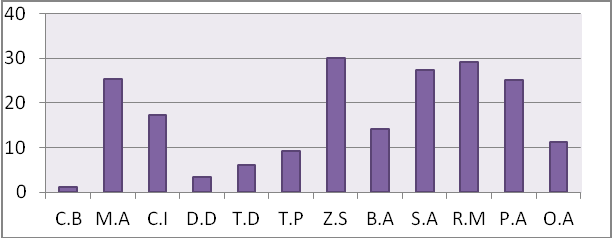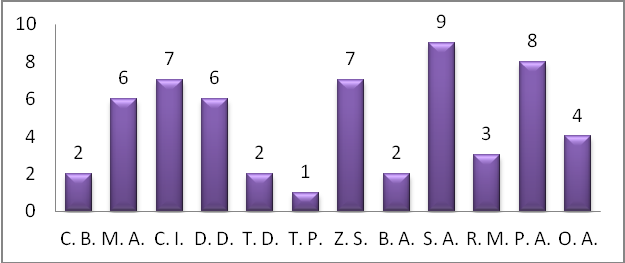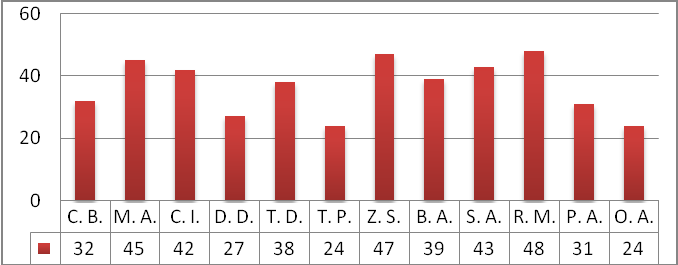Using Motor Skills Tests in the Selection of Women Gymnasts for Learning the “Forward Danilova” on Beam
Abstract
Artistic gymnastics is such a spectacular sport due to the strength and elegance of women gymnasts, as well as to the difficulty of exercises they perform. Gymnastics has seen a considerable rise over the years. We can appreciate that technical level has reached now its upper limit, for example the execution correctness and the complexity of artistic level are the most important methods that may difference between two gymnasts equal in terms of technical performance. The learning of any element, in our case the “Free (aerial) forward walkover, landing on one foot”, Forward Danilova on beam, must be preceded by verification of the motor skills that condition the execution. Any aimed improvement will gradually lead to independent and creative execution of the element and whole exercises. In this research, motor skills tests were used to evaluate certain components of coordination ability, considered fundamental in the learning of any element, and results were applied to select the 6 gymnasts who accomplished the program for learning the “Free (aerial) walkover forward, landing on one foot”. Also, results of the following motor skills tests: Balance rail, Bass test, Fukuda test, Miron Georgescu test demonstrated that the different levels of motor skills of women gymnasts put their mark on learning of the technical element studied.
Keywords: Artistic gymnastics, motor skills tests, balance beam
Introduction
Analysis of major competitions in recent years highlights that women’s artistic gymnastics is
developing continuously, especially in terms of increasing difficulty, complexity and vision it
exercises, while perfecting the art and skill of execution. In artistic gymnastics, the learning of any
technical element is carried out based on a physical support that includes the integration of specific
motor skills and involves the identification of specific technical elements addressed (amplitude, muscle
strength or power, orientation in space, balance). There are also more specific analyses which can be
used as a guide (Dragnea, 1996; Tudor, 2005).
Using the experience gained in 15 years of activity as a high performance gymnast, I want to
underline that the coach should choose for the gymnast a learning element according to his/her
technical knowledge, motor abilities, personal characteristics (the level of fear when starting with a
new element) and morphological characteristics (we choose such elements which biomechanically
better suit to morphological characteristics of gymnasts). Evaluative processes used offer milestones
for control and are designed to ensure maximum effectiveness to training system, both in terms of
directing and especially operating in perspective (Tudor, 2005).
of the researchis that using the motor skills tests in the selection of women
gymnasts shortens the time affected for learning the “Forward Danilova” on balance beam and
provides appropriate gymnasts for learning it.
Materials and methods
This part of the research involved the following motor skills tests:Balance rail, Bass test, Fukuda
test, Miron Georgescu test,and was applied to assess some parts of coordination ability and to select
the 6 gymnasts of 12, who were to accomplish the algorithmic program for learning the “Forward
Danilova” on balance beam.
Procedure and subjects
The first stage in the motor learning is to know what is needed to be done. The coach has to describe
the element to the gymnast. The element “Free (aerial) forward walkover,landing on one foot”
(Forward Danilova) on beam is a dynamic acrobatic element, classified in salto group, which is found
in most integral exercises to balance beam and/or floor exercise and can be presented in many forms.
Depending on the gymnast’s skills, the coach can choose the basic variant (the one shown by us), with
landing on one foot, or landing on both feet. According to the (2008), the element has
the D value, which means a score of 0.40 points.
Rational training at this apparatus requires learning the technique as right from the beginning and to
educate the sense of balance. Competition exercises must contain combinations of elements of static
and dynamic strength that achieve a reasonable balance of forces in time and space, but also elements
of suppleness, flexibility and balance, resulting from the effect of conjugate plasticity, expressiveness
and harmony of movement (Vieru, 1997). From the beginning, we are always dealing with three kinds
of exercises (Čuk & Karácsony, 2004):
•Preparatory exercises - to develop the motor abilities; •Pre-elements - to train the movement structures entirely or partially similar to our chosen element; •The element as a whole (in easier and normal conditions).
For progress in gymnastics, good conditioning is a prerequisite, but to prepare a good conditioning
program, it is important to know how a muscle works, what motor abilities are important for learning
the elements and with what means we can measure and develop important motor abilities.
Evaluation of the content elements specific to sports training is presented as a system of structured
assessment types with internal logic (Dragnea, 1996). To find the start level, the quality and quantity of
knowledge already acquired by the experiment group, we applied test selection and objectification of
motor skills.
that we have applied are the following:
(Cordun, 2011) is represented by a piece of wood with 4.5 cm in thickness and 10 cm
in width (high beam). From standing position on one leg, with the other leg bent forward to passe,
hands on hips and eyes closed, the gymnast must maintain balance as long as possible. With this test,
we check the balance of the gymnast.
is best used in motor activity. A total of 10 rounds are marked on the ground at certain
distances. From standing position on one leg, the gymnast must perform successive jumping from one
foot to the other to keep balance for at least 5 seconds. We use this test to check the gymnast’s balance.
assesses the gymnast’s deviations from the imaginary line, while traveling with
alternative knee lifting 50 times, the eyes being closed. We followed the gymnasts who managed to
keep as much direction during the movement.
is aimed to determine the defining elements of neuromotor qualities, power
and control in the triple extension, in a maximum strength-velocity effort. It includes three series of 15
rebounds on both legs, right leg and left leg, with about a 30-second break between series. The trial is
maximal, assuming in each rebound to achieve maximum flight time and minimum contact with the
ground” (Stroescu, 2014).
After obtaining results from these tests, we selected the 6 gymnasts from a total of 12.
Results
In the selection of gymnasts for applying the experiment variable, namely the algorithmic learning
program for the “Forward Danilova” on balance beam, four motor skills tests were applied in order to
assess the motor potential of the gymnasts. The first test we have applied is Balance rail (Table 1).
The 6 gymnasts who have exceeded the average of 16"68 are:25"32,17"25,30"18,
27"35,29"30,25"15(Fig. 1).

The time maintained in each circle at the dynamic balance test - Bass test is specified in Table 2.
Gymnasts who have achieved the requirements are presented in Table 3 and Figure 2.

Fukuda test results are shown in Table 4.
M.A., C.I., Z.S., B.A., S.A. and R.M. recorded the highest number of steps at Fukuda test (Fig. 3).

Miron Georgescu results are shown in Tables 5 and 6.
Gymnasts who had the best height during stripping and the best time contact with the ground are:
M.A., C.I., Z.S., B.A., S.A. and R.M.
To verify the usefulness of the chosen tests and the influence of the main motor skills during the
learning process of the element studied, we divided the gymnasts into two groups of 6 and submitted
them to a test which consisted in inclusion of the Forward Danilova in the execution of the full
exercise. The differences and the score achieved in the 4 tests are shown in Table 7.
The first group consisted of gymnasts who, after testing, occupied positions 1-6, and the execution
penalties were between 0.05-0.35 points. The second group had the gymnasts from positions 6-12, and
the execution penalties were between 0.40-0.65 points.
Conclusions
The results of motor skills tests intended to evaluate certain components of coordination ability:
Balance rail, Bass test, Fukuda test, Miron Georgescu test,considered fundamental in learning,
demonstrated that the different levels of motor skills in women gymnasts put their mark on the learning
of “Free (aerial) forward walkover,landing on one foot” (Forward Danilova) on beam.
Analysing results in Table 7 and through the correlation coefficient (Table 8) presented above, we
find that M.A., C.I., Z.S., S.A., R.M. and P.A. are gymnasts who have achieved the best six scores in at least three tests applied. These gymnasts showed a high motor potential and recorded the best results in the tests designed to assess the quality of execution of the element we have studied.
References
Code of Points (2008). Retrived from http://www.codeofpoints.com/
Cordun, M. (2011). Bioenergetică și ergometrie în sport. București: CD Press.
Čuk, I., & Karácsony, I. (2004). Vault-Methods, Ideas, Curiosities, History. Sangvincki.
Dragnea, A. (1996). Antrenamentul sportiv. București: EDP.
Stroescu, S. (2014). Valorificarea factorilor interni ai capacităţii de performanţă prin algoritmizarea învăţării unor elemente tehnice cu rotație în ax transversal din Gimnastica Artistică feminină (Teză de doctorat). UNEFS, Bucureşti.
Tudor, V. (2005). Măsurareşi evaluare în cultură fizică şi sport. București: Alpha.
Vieru, N. (1997). Manual de gimnastică sportivă. București: Driada.
Copyright information

This work is licensed under a Creative Commons Attribution-NonCommercial-NoDerivatives 4.0 International License.
About this article
Publication Date
10 June 2016
Article Doi
eBook ISBN
978-1-80296-010-5
Publisher
Future Academy
Volume
11
Print ISBN (optional)
-
Edition Number
1st Edition
Pages
1-509
Subjects
Sports, sport science, physical education
Cite this article as:
Stroescu, S. A. (2016). Using Motor Skills Tests in the Selection of Women Gymnasts for Learning the “Forward Danilova” on Beam. In V. Grigore, M. Stanescu, & M. Paunescu (Eds.), Physical Education, Sport and Kinetotherapy - ICPESK 2015, vol 11. European Proceedings of Social and Behavioural Sciences (pp. 469-476). Future Academy. https://doi.org/10.15405/epsbs.2016.06.65

